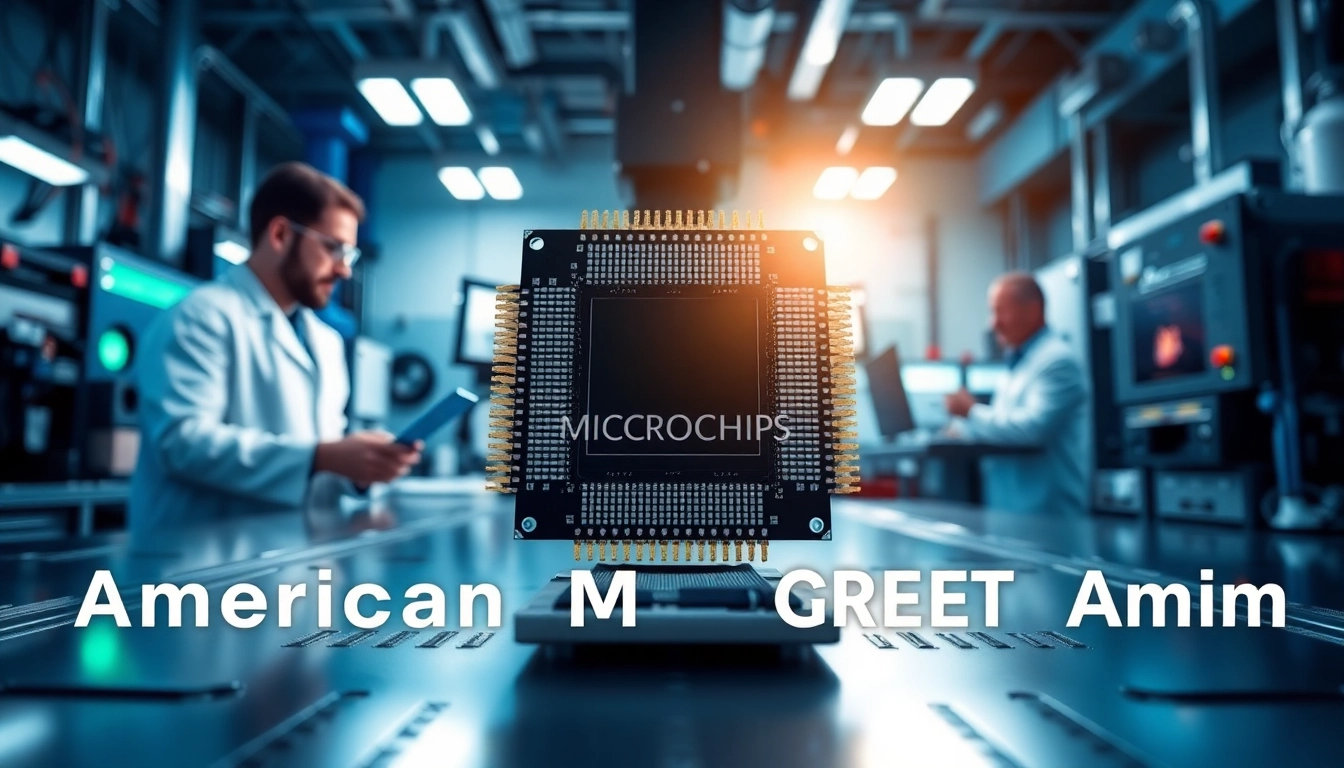Understanding the Importance of Microchips in Today’s World
In the fast-paced digital landscape of the 21st century, microchips have become the backbone of modern technology, driving everything from smartphones and computers to medical devices and automobiles. The growing reliance on these tiny silicon components has highlighted the pressing need for a robust domestic microchip manufacturing industry in the United States. As the global marketplace evolves, understanding the importance of microchips is paramount, particularly in regard to the GREAT potential for American innovation and security.
The Role of Microchips in Modern Technology
Microchips, or integrated circuits, are small semiconductor devices made up of thousands to billions of tiny components, including transistors, resistors, and capacitors. These intricate devices are essential for the functionality of countless technologies. They serve as the brains of computers, enabling data processing and storage, as well as powering numerous smart devices that define our daily lives. With the rise of the Internet of Things (IoT), the significance of microchips has only amplified, as more devices become interconnected.
Global Demand for Advanced Microchips
The demand for advanced microchips is escalating globally, driven by innovations in artificial intelligence (AI), 5G technology, and electric vehicles (EVs). Countries across the globe are investing heavily in semiconductor research and development, leading to a fierce competition to dominate this key technology sector. The statistics are telling; according to industry reports, the global semiconductor market is projected to reach nearly $1 trillion by 2030, indicating an extensive growth trajectory that American manufacturers must capitalize on.
Challenges Facing American Microchips
Despite the demand, American microchip manufacturers face several challenges. Over the past few decades, the U.S. has seen a significant decline in semiconductor production capabilities. Issues such as supply chain disruptions, dependency on foreign manufacturing, especially in Asia, and the constant pressure to innovate have hindered the growth of domestic microchip production. Additionally, competition from global leaders like Taiwan and South Korea, who have made substantial investments in semiconductor technology, poses a formidable hurdle for U.S. companies aiming to reclaim a leading position in the market.
Key Benefits of Domestic Microchip Production
Establishing a strong microchip manufacturing base in the United States offers numerous benefits that extend beyond just economic gains. Here are the primary advantages that would arise from robust domestic production.
Economic Growth and Job Creation
Revitalizing the American microchip industry is expected to stimulate economic growth and create thousands of jobs across the country. Manufacturing microchips requires a highly skilled workforce, ranging from engineers and technicians to research scientists. By investing in semiconductor manufacturing, the U.S. can provide sustainable job opportunities in fields such as technology, engineering, and manufacturing, thereby boosting the economy and reducing unemployment rates.
National Security and Technological Independence
National security is another critical reason for enhancing domestic microchip production. A strong domestic supply chain reduces reliance on foreign entities, which can pose strategic risks, especially in times of geopolitical tension. Having the ability to produce microchips locally allows the U.S. to safeguard its technological infrastructure and maintain control over specific critical technologies.
Innovation Boost through Local Manufacturing
The proximity of manufacturing facilities to research and development institutions cultivates an environment ripe for innovation. Local manufacturing can lead to rapid iterations of new technology, facilitating faster product development cycles. By fostering collaboration between universities, research facilities, and industry stakeholders, the creation of groundbreaking microchip technologies becomes achievable, thus positioning the U.S. at the forefront of the semiconductor revolution.
Best Practices in Microchip Manufacturing
To ensure the quality and efficiency of microchip production, adopting best practices in the manufacturing process is essential. This section outlines effective strategies that can pave the way for sustainable and high-quality semiconductor manufacturing.
Quality Control Measures
Quality control (QC) is a crucial aspect of semiconductor manufacturing. Implementing rigorous QC measures ensures that microchips meet the necessary industry standards and specifications. Techniques such as statistical process control (SPC), failure mode and effects analysis (FMEA), and continual monitoring of production processes can prevent defects and enhance the overall yield. Additionally, certifications such as ISO 9001 are significant in guaranteeing that manufacturing processes adhere to internationally recognized quality standards.
Innovative Manufacturing Techniques
Incorporating cutting-edge manufacturing technologies is vital for maintaining competitiveness in the semiconductor industry. Methods such as extreme ultraviolet lithography (EUV) allow for the production of smaller and more powerful chips. Implementing automation and robotics in production can optimize efficiency and reduce labor costs. Furthermore, collaborative robots, or cobots, are increasingly being integrated into production lines to assist human workers, enhancing precision and safety.
Sustainability in Chip Production
As environmental concerns continue to grow, sustainability in microchip production has become a key focus. Developing environmentally friendly manufacturing processes, minimizing waste, and increasing energy efficiency can reduce the carbon footprint of semiconductor production. Initiatives such as utilizing renewable energy sources and developing recyclable materials for chip packaging not only enhance corporate responsibility but can also attract eco-conscious consumers and investors.
Investing in Microchip Technology: What You Need to Know
Investing in microchip technology is essential for both government and private sectors aiming to advance domestic manufacturing capabilities. This section provides insights into funding opportunities, educational programs, and potential partnerships.
Funding Opportunities and Grants
Various funding opportunities exist for companies and research institutions focusing on semiconductor technology. Government grants, such as those offered by the National Science Foundation (NSF) and the Department of Defense (DOD), provide essential financial support for research and development initiatives. Private investment from venture capitalists and technology incubators can also stimulate innovative start-ups in the microchip industry. Combining these resources could catalyze advancements that propel America back into a dominant position in microchip production.
Educational Programs in Semiconductor Engineering
Training the next generation of engineers and technicians is crucial for sustaining the microchip industry. Educational institutions must focus on developing specialized programs in semiconductor engineering and related fields. Partnerships with industry leaders can enhance curricula, ensuring that students acquire the essential skills and knowledge needed for the rapidly evolving sector. Additionally, internship programs and co-op opportunities with semiconductor companies can provide invaluable hands-on experience for students.
Partnerships Between Government and Industry
Collaborative efforts between government and industry are pivotal for fostering a competitive microchip ecosystem. Such partnerships can lead to R&D initiatives that address pressing industry challenges. Public-private partnerships (PPPs) can facilitate resource sharing, funding for innovative projects, and the establishment of technology transfer programs that enhance the flow of knowledge between academia and industry.
Measuring Success in Microchip Manufacturing
To assess the success of domestic microchip production efforts, stakeholders must establish performance metrics and continually evaluate innovation trends. This section discusses the key aspects of measuring advancement in the semiconductor industry.
Performance Metrics for Domestic Production
Defining appropriate performance metrics is essential for evaluating domestic manufacturing success. Key performance indicators (KPIs) such as yield rates, time to market, production costs, and research and development investment return must be monitored. Gathering data on these metrics allows stakeholders to gauge progress and make informed decisions. Additionally, implementing lean manufacturing principles can improve operational efficiency and waste reduction, further enhancing overall performance.
The Impact of Innovation on Market Competitiveness
Innovation is a driving force in maintaining competitiveness within the microchip industry. By continuously developing new technologies and improving existing ones, American manufacturers can differentiate themselves in the global market. Regular engagement with emerging technologies such as quantum computing and advanced packaging techniques can enable U.S. companies to stay ahead of international competitors. Understanding and adapting to market trends is essential for capitalizing on new opportunities and preserving technological leadership.
Future Trends in American Microchip Manufacturing
Looking ahead, the future of American microchip manufacturing will be influenced by several key trends. As artificial intelligence and machine learning applications grow, the demand for specialized chips tailored to specific tasks is expected to rise. Moreover, the push for greener technologies will continue to drive innovations in sustainable production practices. Additionally, as 5G deployment accelerates, the need for high-performance microchips that support faster data transfer will create new avenues for growth within the industry. Continuous adaptation to these trends will be vital for establishing a resilient and thriving American microchip sector.



